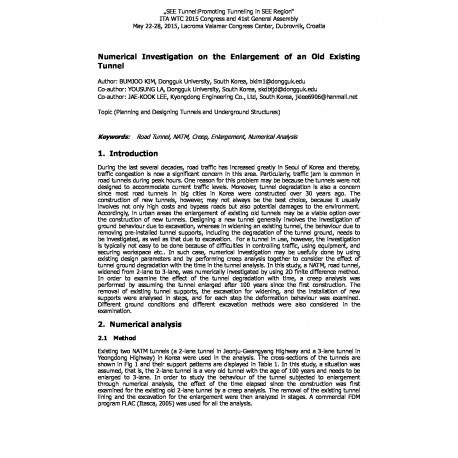Cart
0
0
No document
0,00 €
Total
Document successfully added to your shopping cart
Quantity
Total
There are 0 items in your cart.
There is 1 item in your cart.
Total documents
Total shipping
To be determined
Total
Search & filter
Search for a publication
Search & filter
Viewed documents

Numerical Investigation on the Enlargement of an Old Existing Tunnel
wtc2015_full_kimb
During the last several decades, road traffic has increased greatly in Seoul of Korea and thereby, traffic congestion is now a significant concern in this area. Particularly, traffic jam is common in road tunnels during peak hours. One reason for this problem may be because the tunnels were not designed to accommodate current traffic levels. Moreover, tunnel degradation is also a concern since most road tunnels in big cities in Korea were constructed over 30 years ago. The construction of new tunnels, however, may not always be the best choice, because it usually involves not only high costs and bypass roads but also potential damages to the environment. Accordingly, in urban areas the enlargement of existing old tunnels may be a viable option over the construction of new tunnels. Designing a new tunnel generally involves the investigation of ground behaviour due to excavation, whereas in widening an existing tunnel, the behaviour due to removing pre-installed tunnel supports, including the degradation of the tunnel ground, needs to be investigated, as well as that due to excavation. For a tunnel in use, however, the investigation is typically not easy to be done because of difficulties in controlling traffic, using equipment, and securing workspace etc.. In such case, numerical investigation may be usefully done by using existing design parameters and by performing creep analysis together to consider the effect of tunnel ground degradation with the time in the tunnel analysis. In this study, a NATM, road tunnel, widened from 2-lane to 3-lane, was numerically investigated by using 2D finite difference method. In order to examine the effect of the tunnel degradation with time, a creep analysis was performed by assuming the tunnel enlarged after 100 years since the first construction. The removal of existing tunnel supports, the excavation for widening, and the installation of new supports were analysed in steps, and for each step the deformation behaviour was examined. Different ground conditions and different excavation methods were also considered in the Examination.


